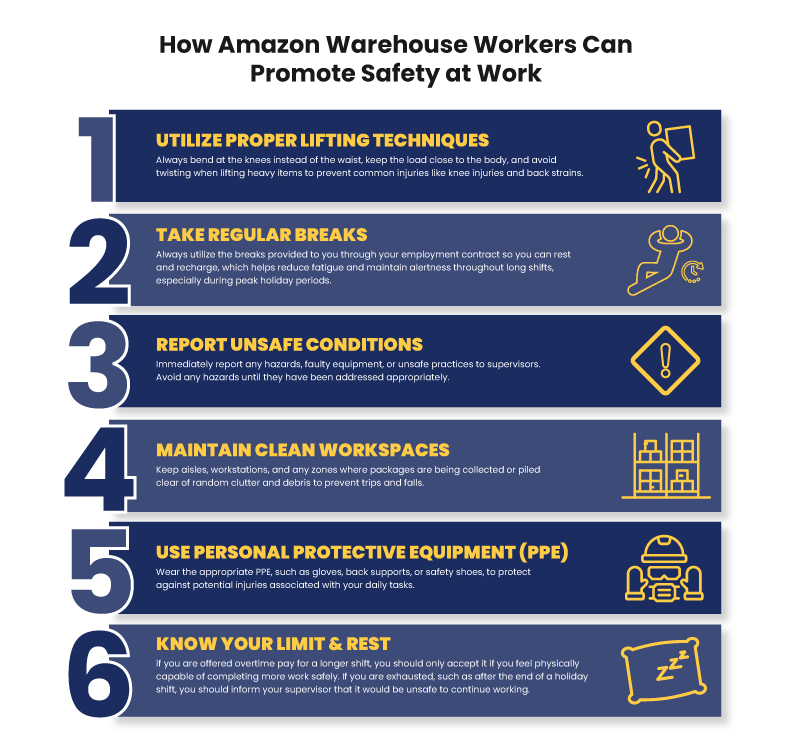As Amazon continues to expand its fulfillment center operations, the health, and safety of its warehouse personnel remain at the forefront of operational priorities. Yet, with the rise of repetitive strain injuries among these workers, questions linger about the effectiveness of the current safety protocols. What measures are in place to protect employees from the physical demands of their roles, and are these measures sufficient? This introduction sets the stage for a deeper look into the multifaceted approach. Amazon's Workplace Safety, highlighting the critical balance between operational efficiency and employee well-being.
Understanding workplace safety within Amazon's vast logistics network involves reviewing policies and assessing their impact in real-time and real-life scenarios. How do seasonal peaks and high demand influence safety standards? Are the legal rights and support systems for injured workers adequate and accessible? By exploring these questions, we aim to provide you with a comprehensive view of the current landscape of workplace safety at Amazon, offering insights and guidance on navigating these challenges effectively in 2024.
1. Analyzing Amazon's Current Safety Protocols in 2024
Amazon's commitment to workplace safety is evident through its array of safety measures and protocols designed to protect its workforce. In 2024, these measures include comprehensive training programs focused on injury prevention and the correct handling of machinery and goods. New employees undergo rigorous orientation sessions where they are educated about potential hazards and the importance of adhering to safety guidelines.
Ergonomic interventions have also been a significant focus for Amazon's Workplace Safety. These are designed to minimize the risk of strain injuries, which are prevalent in warehouse settings. Adjustable workstations, proper lifting techniques, and regular breaks are mandated to reduce physical stress. However, despite these protocols, the effectiveness, and consistency of their implementation often vary across different fulfillment centers, raising questions about uniformity in safety standards.
Furthermore, the training provided to employees is continually updated to reflect new safety technologies and practices. This proactive approach is crucial in maintaining a safe working environment but requires constant vigilance to ensure that all employees, regardless of their tenure, are equally informed and protected.
2. Amazon's Workplace Safety: The Reality Behind Safety Incidents in 2024
Despite robust safety protocols, Amazon fulfillment centers have witnessed several safety incidents in 2024. These incidents range from minor injuries due to slips and falls to more severe cases involving machinery. The frequency and nature of these incidents provide critical insight into areas where existing protocols might be falling short.
Factors contributing to these incidents often include:
Inadequate supervision or enforcement of safety measures.
Insufficient maintenance of warehouse equipment.
The physical layout of facilities, which may not adequately accommodate the high volume of workers and machinery.
During peak seasons, such as holiday sales events, the rate of incidents tends to spike. This increase is attributed to the surge in workforce and operational tempo, which can lead to oversights in safety practices. The challenge lies in scaling safety measures effectively during these peak times without compromising on the speed and efficiency that Amazon's Workplace Safety is known for.
3. Legal Rights and Support for Injured Amazon Workers in 2024
Workers' compensation is a fundamental right for Amazon employees suffering from workplace injuries. In 2024, Amazon has streamlined the process for filing compensation claims, making it more accessible for employees to receive the support they need. However, navigating this process can still be daunting for many, especially without proper guidance.
Injured workers should be aware of the following steps to effectively manage their claims:
Report the injury to a supervisor immediately.
Document the incident and any medical attention received.
Follow through with all company-provided procedures for filing a claim.
Legal advisors play a pivotal role in this process, ensuring that employees are not only aware of their rights, but are also able to exercise them effectively. These professionals provide the necessary advocacy and support, helping workers secure fair treatment and compensation from their employers.
4. Proactive Measures to Enhance Safety for Amazon Workers in 2024
Looking forward, Amazon continues to develop innovative approaches to improve workplace safety. The integration of technology and AI stands out as a promising area. These technologies are used to monitor work environments and predict potential hazards before they lead to incidents. For example, motion-capturing sensors can alert employees if they are performing a task in a manner that could lead to injury.
Strategies to further engage employees in safety protocol development include:
Regular feedback sessions where employees can voice safety concerns.
Inclusion of employee suggestions in the development of new safety protocols.
Training programs that are tailored to the specific needs of different roles within the fulfillment centers.
By fostering a culture of safety that values employee input and leverages advanced technology, Amazon aims to not only react to safety issues, but to anticipate and prevent them. This proactive approach is essential in adapting to the ever-growing demands of the e-commerce industry and ensuring the well-being of its workforce.
How Amazon Warehouse Workers Can Promote Safety at Work
- Utilize Proper Lifting Techniques: Always bend at the knees instead of the waist, keep the load close to the body, and avoid twisting when lifting heavy items to prevent common injuries like knee injuries and back strains.
- Take Regular Breaks: Always utilize the breaks provided to you through your employment contract so you can rest and recharge, which helps reduce fatigue and maintain alertness throughout long shifts, especially during peak holiday periods.
- Report Unsafe Conditions: Immediately report any hazards, faulty equipment, or unsafe practices to supervisors. Avoid any hazards until they have been addressed appropriately.
- Maintain Clean Workspaces: Keep aisles, workstations, and any zones where packages are being collected or piled clear of random clutter and debris to prevent trips and falls.
- Use Personal Protective Equipment (PPE): Wear the appropriate PPE, such as gloves, back supports, or safety shoes, to protect against potential injuries associated with your daily tasks.
- Know Your Limit & Rest: If you are offered overtime pay for a longer shift, you should only accept it if you feel physically capable of completing more work safely. If you are exhausted, such as after the end of a holiday shift, you should inform your supervisor that it would be unsafe to continue working.

Conclusion: Reflecting on Amazon's Workplace Safety Efforts in 2024
Amazon's Workplace Safety continue to expand, the task of ensuring better conditions, although it's increasingly complex. The company's dedication to reducing injuries through comprehensive training, ergonomic improvements, and the adoption of cutting-edge technology demonstrates a proactive stance on employee well-being. However, the ongoing occurrence of safety incidents, particularly during times of maximum operational demand, highlights the necessity for ongoing enhancements in safety protocol adherence and equipment upkeep.
The obstacles Amazon faces in sustaining a safe work environment mirror those seen across the industry, where the pursuit of efficiency can impact safety. It's essential for Amazon to address these challenges and to cultivate an environment where safety is valued alongside productivity. The conversation about workplace safety extends beyond injury prevention; it involves a commitment to the well-being of every employee, ensuring they return home safely. As we progress, let's keep the conversation active and persistently ask, “Is enough being done?” This question isn't merely for contemplation, but a prompt to remain alert and aim for a safer future.

